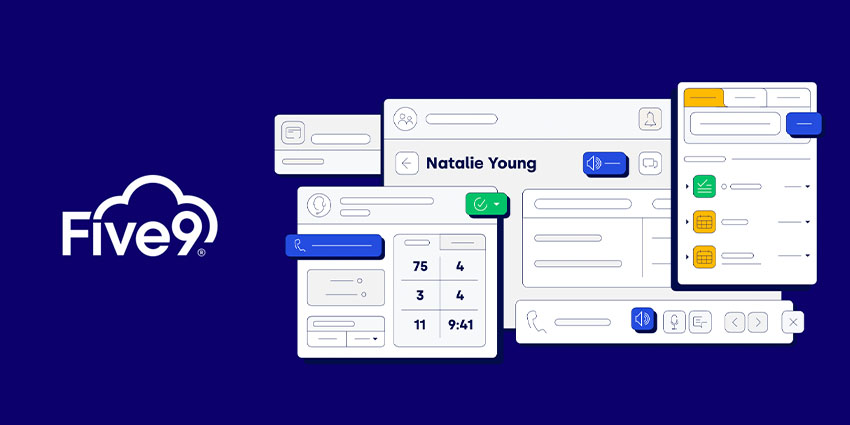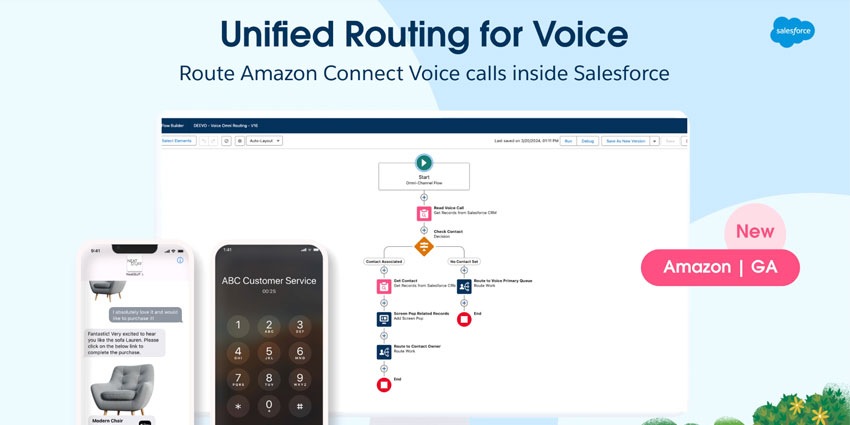The CRM centralizes customer journey data within one application. CX teams can then better manage data throughout the customer lifecycle, share that information, and understand the conversation history of each customer.
Yet, it is through integrations where CRM delivers immense value. Perhaps most notable is its integration with a contact center as a solution (CCaaS) offering.
Nowadays, many CCaaS providers will integrate with several CRM systems. Users may then experience the best of both worlds within one streamlined interface.
For contact center agents alone, this provides many mission-critical features. As Dibyendu Roy, Director of Product Management at Five9, says:
“Based on data such as customer purchases, conversation history, and sometimes sentiment, agents can deliver personalized service experiences that satisfy rising customer expectations”
However, managers may also add other tools into the contact center ecosystem to draw further benefits from the data held within the CRM. Speech analytics, bots, and reporting tools will all drink from this centralized data lake to not only improve operational performance but CX too.
5 Crucial Contact Centre Integrations to Drive CRM Value
Leading CCaaS providers are infusing their solutions with AI. As such, they require a healthy data stream to unlock their full potential. The CRM plays an integral role here, generating the necessary data flow that enables the following technologies to enhance CX.
- Speech Analytics
Speech analytics allows contact centers to isolate customer journey pain points, anticipate customer needs, and track new metrics. Yet, with a CRM integration, it can do much more.
First of all, it adds to the 360-degree view of every customer, which aggregates within the CRM of omnichannel contact centers. An excellent example is inserting emotional insights into this view, thanks to the ability of speech analytics to measure sentiment.
Such data can enhance the sophistication of outbound campaigns and proactive strategies that aim to increase customer retention. Yet, it also adds to the arsenal of customer experience management teams.
After all, emotions elevate CX. Understanding this, companies can adapt their personalization and engagement strategies to provide a more emotionally stimulating experience.
As a Deloitte article suggests: “We all know that customers are humans and that humans have emotions. But sometimes, brands forget to connect those dots.” Combining sentiment analysis with the CRM creates the opportunity to do so.
Another possible use case is speech analytics automating call dispositioning. In doing so, it stores contact reasons within the CRM, improving data accuracy and accelerating the After Call Work (ACW) process.
- Reporting Tools
“Weighing the pig doesn’t make it fatter.” A fabulous saying with particular significance across the contact center industry, a space where analysis without action is commonplace.
Why? Because getting to grips with contact center data is often overwhelming, and leaders have little time to action that data – aka. fatten the pig. Luckily, the CRM arranges the data, making critical insights easier to access.
Yet, reporting tools mine insights to accelerate data analysis further. In doing so, they give contact center leaders the gift of more time to improve customer service experiences through data-driven decision-making.
As a result, execution is no longer the contact center’s weakest link. Operations can learn and act quickly to increase agility, which is a critical facet of the future contact center. Another is collaboration, which Dibyendu Roy highlights:
“By mining data and uncovering critical insights, contact centers can develop a unified view of the CX. Sharing this with other departments enables customer-centricity, which also strengthens the position of the contact center within the enterprise”
- Virtual Assistants
“We see AI and CRM coming together to support intelligent customer-facing chatbots, both enabling self-service and allowing organizations to qualify opportunities before a salesperson gets involved,” says Irwin Lazar, President and Principal Analyst at Metrigy.
Yet, the potential capabilities of integrating the CRM with a virtual assistant extend further. For starters, consider the voicebot. Assessing insights available within the CRM, it facilitates data-driven routing and enables better contact center conversations.
Also, the CRM paves the way for personalized self-service experiences through the voice channel. By allowing the voicebot to dip in and out of the system – retrieving and storing customer data – CX teams can automate multiple contacts. In doing so, they meet the needs of the modern, autonomous customer, who may resolve their queries without lifting a finger through a smart speaker.
Finally, consider virtual agents that work side-by-side with agents. Infused with real-time speech analytics, these monitor customer conversations. As a result, they can proactively present relevant insights from the CRM to the agent as the interaction progresses. Doing so streamlines contact handling while enhancing agent experiences.
- The Agent Desktop
When there is no integration between the CRM and agent desktop, agents must copy and paste information from one system to another. Not only is this process prone to error, but it also slows down the conversation, frustrating customers and agents alike.
An integration paves the way for process automation, limiting such laborious tasks. These extend far beyond copy and pasting. For example, perhaps an agent wishes to send a purchase confirmation message to a customer. Ideally, a simple click of a button will trigger a workflow that harnesses information from the CRM and completes the task in a matter of moments.
By developing such workflows, agents may fully focus on the matter at hand. As contact center contacts grow in complexity – thanks to the rise in self-service and virtual agents – this ability becomes ever more crucial.
- Proactivity and Personalisation Tools
Proactive alerts inform customers and adjust behaviors to optimize their journeys. However, a strategy is necessary to ensure that proactive notifications are helpful, not a nuisance.
Adding rules to customer journey maps is the ideal approach. Companies can trigger proactive notifications at particular touchpoints to push customers along the optimal path and increase their satisfaction. Automatically embedding customer information into these communications – through a CRM integration – also helps to increase engagement.
Yet, to be more adventurous in growing and retaining a customer base, CX teams can connect AI-enriched proactivity tools to the CRM. These scan the system to determine the optimal moment to engage with customers.
By encouraging engagement in such a manner, companies can further revenues and tailor their proactivity strategies to individual customers. In doing so, they evolve their personalization approach.
Such a strategy aligns with the advice of analysts at Forrester Research, who believe: “Businesses need to evolve their definition of personalization – from tactical segmentation to strategic individualization.” A CRM and proactivity tool integration strengthen this approach.
Take CRM Beyond the Contact Center and Into the Enterprise
Of course, the CRM system is a crucial cog within customer service – as well as marketing operations. Yet, thanks to an array of AI innovations drawing more actionable insights from the system, its value is starting to seep into other business areas.
Other technology shifts are also facilitating this trend. The merging of enterprise systems is an excellent example, according to Roy. He says:
“Traditionally, businesses think of CCaaS, UCaas, and CPaaS as separate entities. However, innovative vendors – such as Five9 – strive to converge these into one platform, driving data across the enterprise and unlocking CX collaboration”
Indeed, alliances are forming to unite these solutions. The Five9 and Microsoft Teams partnership is a prime example of this, enabling contact centers to extend their reach across business siloes.
If the contact center exploits this opportunity, collaborates, and funnels CRM insights to non-customer-facing teams, it encourages customer-centricity. Separate functions may well start to align and orchestrate their operations to benefit customers. Along the way, they will likely begin to fix pain points, which drive customer effort.
As this trend develops, roles and workflows within other functions will likely evolve as CRM insights redefine company-wide constructs. Entire hierarchies may shift in the interest of driving the best customer outcomes.
CRM technologies could also advance in line with this trend, tracking the influence of users on individual customer experiences. As a result, companies can match customer outcomes to employee actions to uncover valuable insights that enlighten the path forwards to better CX and performance management.
How Five9 are Facilitating the Evolving Enterprise
To connect the evolving enterprise, leading CCaaS, UCaas, and CPaaS providers are doing more than building API integrations from scratch. Instead, they are forming strategic alliances.
The aforementioned Five9 and Microsoft partnership is an excellent example. Yet, Five9 also fosters relationships with other prominent CRM providers, including Salesforce, ServiceNow, Microsoft, Oracle, and Zendesk, and ServiceNow. By doing so, they get to grips with the roadmap of each vendor, prepare for future trends, and build innovations that enable CX disruption.
Thanks to these close relationships with CRM providers, Five9 also understands the various use cases of how enterprises are harnessing their technology. With this knowledge, the CCaaS provider builds on these to deliver more value. Making this point, Roy states:
“If these enterprises would like to exploit the technology in a way that the CRM vendor cannot, Five9 builds the capabilities especially, bringing differentiated visions of CX to life”
So, by understanding the plans of CRM providers and what their customers’ demand, Five9 builds a roadmap of its own to address the shared needs of clients.
Of course, there are other inputs into this roadmap. Nevertheless, these strategic alliances enable Five9 to build a unique proposition and maximise the immense potential of CRM data.
Combine the Strengths of Different Providers
As technology providers build bonds with counterparts that serve other business siloes, overlaps within their offerings will sometimes emerge. In these situations, it is critical that clients can pinpoint the stronger alternative and ensure seamless workflows.
For example, a company that works with Five9 and Salesforce may merge the digital channel capabilities of both providers to create an advanced omnichannel solution, where context follows the customer as they switch between channels.
In the future, vendors must strive to provide such synergy. After all, a single vendor cannot satisfy the extensive needs of a large enterprise.
Building on this point, Roy says:
“The near future of CX is likely to be more platform-orientated. As such, providers must ensure that customers have more flexibility with CRM software development kits (SDKs) and APIs. In creating such a platform, companies can build and integrate to meet a differentiated vision of CX”
Fortifying such a platform with AI and digital assistants streamlines processes within the connected enterprise. As a result, many of the mundane chores of employees fall by the wayside, empowering them to tackle trickier, more engaging duties.
More CRM Trends That Will Dictate the Future of CX
Not only is the CRM bleeding into other business areas, but its insights are unlocking collaboration, fostering customer-centricity, and redefining company-wide constructs. Each of these trends has the power to bolster CX.
Of course, CRM developments may also enhance employee experiences through automation, and CX will likely benefit as a result. After all, happy employees make for happy customers. Nevertheless, there are many more trends within the CRM space, which complement CX specifically. These include integrating the CRM with:
- The internet of things (IoT) to monitor and support customers in new highly-personal, highly-proactive ways
- Advanced analytics features for a full view of sales, customer churn, and sentiment
- Social media to uncover a high-definition view of customers, their feedback, and overall brand sentiment
The everything as a service (XaaS) model comes to the fore to enable these integrations. As such, each IT model – from every corner of the company – lies in the cloud, available for enterprise consumption.
Through its strategic alliances, Five9 helps enterprises build towards such an ecosystem. As a result, brands can eliminate siloes, share data effortlessly, and paint an all-encompassing view of CX. With every department harnessing this view, departments can sing from the same hymn sheet and work together to improve customer, employee, and business outcomes.
Eager to enhance your CRM strategy and connect the enterprise with invaluable customer insights? Get in touch with a member of Five9’s expert team today.







